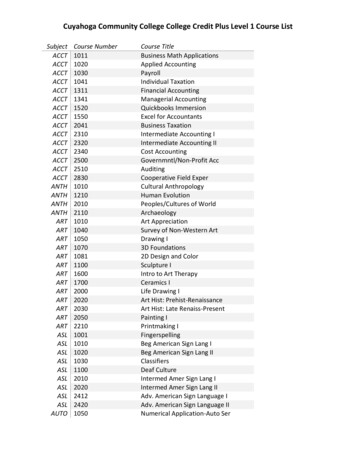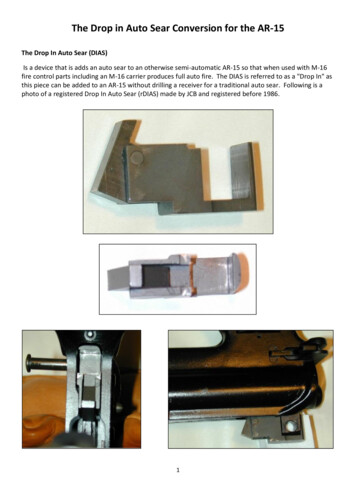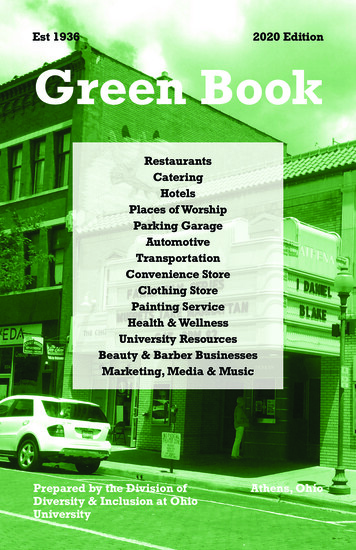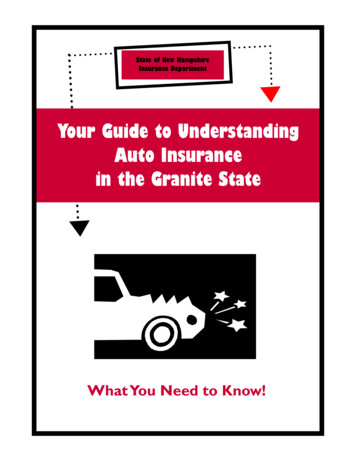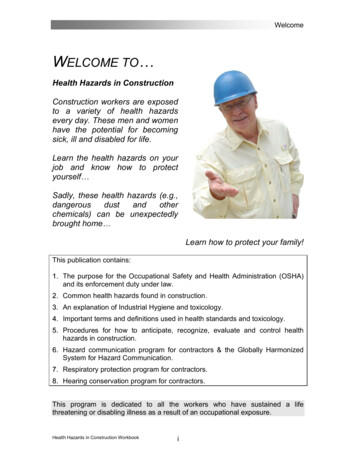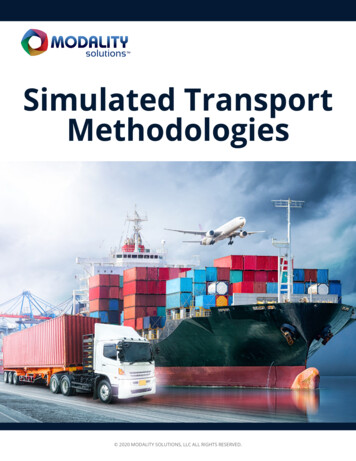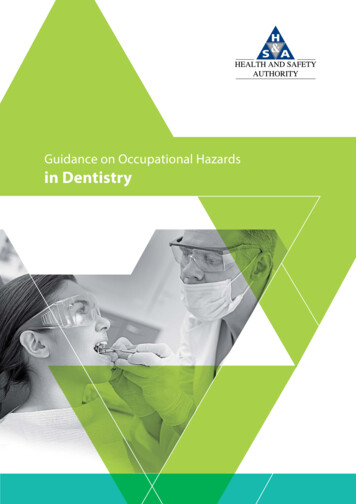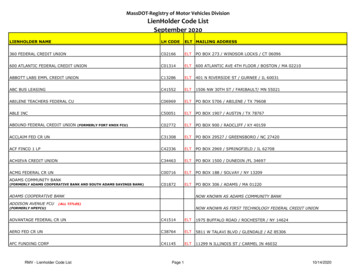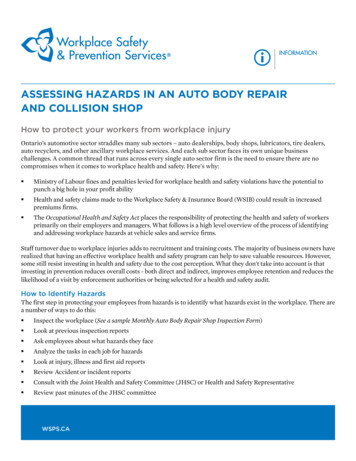
Transcription
Assessing Hazards in an Auto body Repairand Collision ShopHow to protect your workers from workplace injuryOntario’s automotive sector straddles many sub sectors – auto dealerships, body shops, lubricators, tire dealers,auto recyclers, and other ancillary workplace services. And each sub sector faces its own unique businesschallenges. A common thread that runs across every single auto sector firm is the need to ensure there are nocompromises when it comes to workplace health and safety. Here's why: Ministry of Labour fines and penalties levied for workplace health and safety violations have the potential topunch a big hole in your profit ability Health and safety claims made to the Workplace Safety & Insurance Board (WSIB) could result in increasedpremiums firms. The Occupational Health and Safety Act places the responsibility of protecting the health and safety of workersprimarily on their employers and managers. What follows is a high level overview of the process of identifyingand addressing workplace hazards at vehicle sales and service firms.Staff turnover due to workplace injuries adds to recruitment and training costs. The majority of business owners haverealized that having an effective workplace health and safety program can help to save valuable resources. However,some still resist investing in health and safety due to the cost perception. What they don't take into account is thatinvesting in prevention reduces overall costs - both direct and indirect, improves employee retention and reduces thelikelihood of a visit by enforcement authorities or being selected for a health and safety audit.How to Identify HazardsThe first step in protecting your employees from hazards is to identify what hazards exist in the workplace. There area number of ways to do this: Inspect the workplace (See a sample Monthly Auto Body Repair Shop Inspection Form) Look at previous inspection reports Ask employees about what hazards they face Analyze the tasks in each job for hazards Look at injury, illness and first aid reports Review Accident or incident reports Consult with the Joint Health and Safety Committee (JHSC) or Health and Safety Representative Review past minutes of the JHSC committeewsps.ca
Assessing Hazards in an Auto body Repair and Collision ShopYou will probably need to use multiple sources in order to perform a thorough hazard identification. The chart below(Major Hazards) lists the major hazards found in auto body repair facilities (according to Ontario's Ministryof Labour).For further details on hazards in yourworkplace, consult these WSPS solutions Managing Hazards Inspecting your Workplace Inspecting Physical ConditionsGuidelines for Setting StandardsMajor Hazards Hoists Designated Substances e.g. Isocyanates Driving Dispensing and storage of flammable andcombustible liquids Availability and use of Personal ProtectiveEquipment Bonding and grounding Chemical Hazards Sandblasting Storage of waste paint/solvents Compressed gas Explosions due to cross mixing of solvent andwaterborne waste streamsHow to Assess the Significance of HazardsNot all hazards are created equal. Some may be minor or very unlikely to occur. Others may be verylikely to occur or have serious consequences.Once you have identified all the hazards in your workplace, use the Hazard Management Tool (includedat the end of this document) to rank them as high, medium or low. The form will help you to give eachhazard a risk rating. A risk rating takes into account the probability of a hazard causing an accident andthe severity of the consequences should an accident occur. The ranking will tell you which hazards toaddress first.wsps.ca2 2013, Workplace Safety & Prevention Services.1 877 494 WSPS (9777) 905 614 1400 www.wsps.ca
Assessing Hazards in an Auto body Repair and Collision ShopHow to Address Significant HazardsStarting with your highest ranked hazards, look for ways to eliminate or control them. Hazard controls aremeasures or barriers designed to eliminate or reduce the risk of exposure to the hazard. Some examples ofhazard controls: Keeping floors clean and free from grease, water or wires running across floors and walkways. Uneven floorsshould ideally be marked. Training employees on safe lifting and carrying techniques (trays, boxes) Personal Protective Equipment (PPE) such as gloves, goggles, or masks Guards to protect employees from a machine’s blade or moving part A procedure that outlines how to perform a task safelyHazards can be controlled in one of three locations; at the source, along the path, or at the worker.At the source source refers to eliminating the hazard entirely. This is the ideal method of control.Along the path refers to the flow of materials and processes through the workplace. A control along thepath would place a barrier between the employee and the hazard.At the worker refers to a means of protecting the employee from the hazard. This includes PersonalProtective Equipment (PPE) such as gloves, goggles, or masks. A control at the worker is the leasteffective and should be a last resort.When you address hazards, also make sure to take into account the legislation and best practices that apply tothat hazard.How to Put Controls into ActionThe final step in protecting employees from hazards is to implement your controls.For each hazard, write an action plan to outline what actions will be taken to control it.Assign someone to be responsible for each action, and a date for completing it. Make surethe action steps are achievable and the timeframes are realistic.Your plan should include informing employees about how the hazard will be addressed,or training them on how to deal safely with the hazard. After the plan is implemented,follow up to make sure that the controls are successful.wsps.ca3 2013, Workplace Safety & Prevention Services.1 877 494 WSPS (9777) 905 614 1400 www.wsps.ca
Assessing Hazards in an Auto body Repair and Collision ShopMonthly Auto Body Repair Shop Inspection FormName of personconducting inspection:Name of business:Date of inspection:Paint BoothYesNoNAAre workers educated on the hazards associated with the paints in the shop?Is all painting done in the paint booth?Are booth filters inspected and replaced at regular intervals?Are there written standard operating procedures for the selection and use ofrespirators?Are employees instructed on the correct usage and limitations of the respirators?Are respirators regularly inspected, cleaned, sanitized, and maintained?Are spray guns cleaned and regularly maintained?Are workers taking part in the medical surveillance program when Isocyanatebased paints are used?Are defective spray guns immediately taken out of service and repaired or replacedas appropriate?Do workers wash their hands before eating, drinking or smoking?Are work clothes placed in the laundry bins provided prior to leaving work?Are hazard warning signs posted?Are Air Feed Compressors properly maintained and serviced?Is there an adequate written control program and training on the use, care,selection and maintenance of PPE?ACTION REQUIRED:wsps.ca4 2013, Workplace Safety & Prevention Services.1 877 494 WSPS (9777) 905 614 1400 www.wsps.ca
Assessing Hazards in an Auto body Repair and Collision ShopPaint Storage and Handling AreaYesNoNAYesNoNAAre paint containers stored in the flammable storage cabinet or room?Are all sources of ignition removed from the paint booth and storage area?Are containers and dispensing equipment bonded and grounded?Have safe work procedures based on manufacturer’s instructions been established?Are workers trained in the hazards of chemicals and in procedures for their safeuse, spill clean up and disposal?Is the ventilation system regularly inspected and properly maintained?Are approved containers and tanks used for the storage and handling of flammableand combustible liquids?Are procedures in place to prevent cross contamination between solvent based andwaterborne based paints?Are all paint and solvent containers properly labeled?Do storage rooms have explosion-proof lights and adequate ventilation?Are spills of flammable or combustible liquids cleaned up promptly?ACTION REQUIRED:Prep StationsAre paint booth filters inspected and replaced at regular intervals?Are workers educated on the chemical hazards associated with sanding and fillingmaterials?Are there written standard operating procedures for the selection and use of masksand respirators?Are dust vacuum systems serviced and maintained properly?Are all warning signs for hazards, PPE and safe procedures posted in the area?ACTION REQUIRED:wsps.ca5 2013, Workplace Safety & Prevention Services.1 877 494 WSPS (9777) 905 614 1400 www.wsps.ca
Assessing Hazards in an Auto body Repair and Collision ShopRepair AreasYesNoNAAre workers educated on the hazards associated with hoists, jacks and framestraighteners?Are machines located to provide operators with sufficient space to work safely?Are safe work procedures in place and followed for all welding and cuttingoperations?Are gas cylinders properly chained?Are oxygen and acetylene tanks stored separately?Are pinch points, in-running nip points and points of operation guarded?Are standard operating procedures in place and operator competency tested?Are operating and maintenance records kept?Is a program in place for lock-out-tag-out in place for maintenance equipment?Is Apprenticeship training and certification up to standards?Are interlocked guards operative and in good condition?ACTION REQUIRED:Inspection reviewedby Manager:Date: Workplace Safety & Prevention Services 2012. Workplace Safety & Prevention Services (WSPS) grants permission to approvedend users to reproduce this document in whole or in part, provided its intended use is for non-commercial, educational purposesand that full acknowledgement is given to the WSPS. Approved end users are firms registered with the Workplace Safety andInsurance Board. WSPS reserves the right to extend this permission to other stakeholders and interested parties by express writtenpermission upon application. WSPS extends no warranty to materials amended or altered by the end user. Under no circumstancesis this document, or any portion thereof, to be duplicated for purposes of sale or for external reproduction or distribution.Revised: November 2012wsps.ca6 2013, Workplace Safety & Prevention Services.1 877 494 WSPS (9777) 905 614 1400 www.wsps.ca
Hazard Management Toolwsps.ca
Developed by the Workplace Safety and Insurance Board in collaboration with the Health and Safety Ontario members: Infrastructure Health and Safety Association Public Services Health & Safety Association Workplace Safety North Workplace Safety & Prevention ServicesHazard Management Tool1
2The Hazard Management Tool template is shown in the page below. Instructions on how to complete the toolare explained in the pages that follow.The legal duties and responsibilities of employers, supervisors and workers overlap and complement eachother. Employers have a duty to actively ensure workers are safe. Every worker who has a health and safetyconcern has a duty to report the situation to their supervisor or employer. Workers may also report theseconcerns to their health and safety representative. Once a hazard has been identified, the employer andsupervisor have a duty to assess and eliminate any potential harm for workers.The Occupational Health and Safety Act, Ontario's law that governs health and safety in the workplace,establishes legal duties and minimum responsibilities for employers, supervisors and workers. If these dutiesare not followed, injuries, illness or even the death of a worker can result. Contact with Machinery Falls Motor Vehicle Incidents Musculoskeletal Disorders (Strains and Sprains)The information in this tool is generic and not targeted to any specific type of workplace, industry sector orwork task. It is helpful to keep in mind that in Ontario the leading causes of lost time injuries and fatalitiesare related to:There are many hazard and risk assessment tools available. If you already have one in place, comparing yourtools to this tool will be helpful when considering modifications or improvements. For workplaces that do nothave a hazard assessment tool, using this tool will help you get started.The purpose of this Hazard Management Tool is to provide workplaces with a step- by- step approach torecognize assess and control hazards and monitor the ongoing effectiveness of controls.Introduction
Servicebaytechsworkingundercars Job Titles WorkActivitiesWhatactivity cancauseinjury orillness?PhysicalWhat hazardgroups(categories)can causeinjury orillness? Physical Biological Chemical MSD Psychosocial SafetyCarfalling offhoist/carjacksWhatpotentialhazardscan causethe workerinjury andillness?CMajor Major Moderate Minor High Medium LowMediumHow seriouscould theharm be?ASSESSEHow likelyare thehazards tocause injuryor illness?DHigh(Use theanswersfrom D & Eand ploton theabove riskevaluationchart) High Medium LowWhat isthe risklevel forthishazard?FOHSATSSAIndustrialRegulationWhat legalrequirements/ standardsapply to GMaintenanceon hoistSafeOperatingProceduresWhat iscurrently beingdone toeliminate orcontrol ningIncreaseInspections,revisemaintenance &Safe OperatingProcedures,Revise WorkerWhat futureactions areneeded toeliminate orcontrol hazards?IRisk Evaluation ChartLow High Medium LowHow likelyis thehazard tocauseinjury orillnessnow?JMajor High Medium Low Major Moderate Minor4Medium(Use theanswersfrom J & Kand ploton theabove riskevaluationchart)What isthe risklevel forthis hazardnow?LLowLowMediumLowHow seriouscould theharm benow?EVALUATEKLowMediumHighMediumProbability of InjurySr. Manager Signature:CONTROLHSr. Manager Review Date:Work Area/Department:RECOGNIZEBJHSC/Representative Review Date:Person Completing:AAssessment Date:Name of Firm:HAZARD MANAGEMENT TOOLSeverityof Injury
Process (work design, flow, reporting requirements, work practices, policies and procedures) Environment (noise, temperature, air quality, lighting, physical layout and structure, housekeeping) Materials (correct use, adequate supply, repair and maintenance, proper storage) Equipment (protective equipment, repair and maintenance, adequate clearance) People (training, coaching, communication, education, hygiene practices, etc.)The following factors contribute to creating hazards: Safety Psychosocial Musculoskeletal Biological Chemical PhysicalHazards can be grouped as:A hazard is a condition, practice or substance with the potential for causing loss, injury or harm to life, healthor property.Column B – What hazard groups (categories) can cause injury or illness?5Identify what job titles, work activities, and work areas to assess. Remember to think about tasks that may beperformed in normal and abnormal or emergency situations.Column A – What activity can cause injury or illness?STEP 1 - RECOGNIZE HAZARDS (Columns A,B,C)
For example: exposure to chemicals fall from heights or ladders coming into contact with moving parts of machinery exposure to noise exposure to heat/cold extremes exposure to situations where harassment and violence may occur.Identify what potential hazards can cause injury or illness to the workers if exposed to each hazard.Column C – What potential hazards can cause the worker injury or illness?You may need to consult with a health and safety expert where specialized expertise is needed. It may benecessary to take measurements or samples to determine if a hazard is within recommended limits.Review the following workplace information to help identify hazards in your workplace: Worker comments, feedback and reports of concerns Workplace inspection records Incident investigation reports, First Aid reports Supervisor’s inspection reports and shift notes Material safety data sheets (MSDSs) Hazard alerts or bulletins Regulations, technical standards and codes (e.g. building code, fire code) Industry best practices Manufacturer’s instructions and specifications Established occupational exposure limits Human resources related data such as absentee records and turnover rates.6
3. Safety: Exposure to compressed air.4. Physical: Potential contact withmoving vehicles while walking inparking lot to retrieve customervehicles.3. Safety hazards present4. Physical hazards present5. Psychosocial hazards present3. Working with compressed air4. Pedestrian activities in parking lot5. Interaction with other workersand customers75. Psychosocial: Interactions withcoworkers, supervisors and customers.2. MSD: Pushing, pulling, lifting,bending, awkward body positions,grasping parts and tools.2. MSD hazards present2. Working with hand tools1. Chemical: Automotive lubricants,degreasers and parts cleaners.Potential/actual exposures to hazardsunder each hazard group identified incolumn B.1. Chemical hazards presentHazard Groups presentPhysicalChemicalBiologicalMusculoskeletal Disorders (MSD)Psychosocial Safety1. Working with chemicalsService Bay TechniciansJob Titles Work Activities Consider:Consider:List: CWhat potential hazards can causethe worker injury or illness?BWhat hazard groups (categories)can cause injury or illness?RECOGNIZEAWhat activity can cause injury orillness?WORKSHEET – STEP 1: Recognize
There is a chance that the hazard will cause injury or illnessThe hazard will probably not cause injury or illnessMediumLowThe hazard could cause fatal or serious injury, illness and/ordamage, resulting in permanent or long term disability and/orsignificant lossThe hazard could cause moderate injury, illness and/or propertydamage resulting in lost timeThe hazard could only cause minor injury or illness without losttime or other lossMajorModerateMinorSEVERITY RATINGEstimate how serious the injury or illness could be using a scale of major, moderate or minor.Column E - Severity: How serious could the harm be?Injury or illness due to exposure to this hazard is very likelyHighPROBABILITY RATING historical dataConsider: nature of exposure time spent exposed number of workers exposed how often they are exposedEstimate using high, medium or low, how likely or probable it is that the hazard will cause injury or illness ordamage to property.Column D – Probability: How likely is the hazard to cause injury and illness?STEP 2 - ASSESS HAZARDS (Columns D,E,F)8
ediumProbability of Injury(Column D)Risk Evaluation ChartLowLowMediumLowPlot, using the Risk Evaluation Chart below, the Probability of Injury from Column D and the Severity of Injuryfrom Column E. Enter the result in Column F. This helps determine the level of risk for each hazard. Prioritizeso that the hazards with the highest risk are controlled first.Probability of injury Severity of injury RiskColumn F - What is the risk level for this hazard?Severity of Injury(Column E)9
HighMediumLow5. LowInteraction with other workers and customers4. LowPedestrian activities in parking lot3. LowWorking with compressed air2. MediumWorking with hand tools1. LowChemical exposure potential How likely is the hazard to cause harm?DProbability:ESeverity:ASSESS5. Moderate4. Major3. Major2. Moderate1. Moderate Major Moderate MinorHow serious could the harm be?WORKSHEET – STEP 2: Assess Hazards5. Low4. Medium3. Medium2. Medium1. LowUse Risk Evaluation Chart to determinerating.What is the risk level for this hazard?FRisk:10
11Remember controls like personal protective equipment only control the exposure to the hazard not the hazarditself. Use personal protective equipment, and ensure appropriate selection, use and maintenance of it. Use administrative controls such as training, and procedures Increase awareness about hazards and controls through for example, warning systems, alarms and signs Use engineering controls to prevent access, limit exposure, or reduce energy available that may harmworkers Substitute with other materials, processes or equipment Eliminate the hazardIdeally, controls should be designed to eliminate a worker’s exposure to the hazards. Make sure that hazardcontrols do not create new hazards. You should work through the hierarchy of controls:Column I – What future actions are needed to eliminate or control hazards?Identify what control measures are currently in place.Column H – What is currently being done to eliminate or control the hazard?Ensure that all legislative authorities and standards/guidelines are consulted. This will ensure that whatshould be in place is known to the Managers, Supervisors and Workers. If the standards are not being met,then the changes can be put into the Hazard Assessment Tool under Column I for future consideration.Legislation/Regulations/Standards are subject to change from time to time and should always be consultedduring this review process.Identify the legal requirements and standards as they apply to the identified hazards, work processes andactivities.Column G – What legal requirements and/or standards apply to the identified hazards, work processes,work activities?STEP 3: CONTROL HAZARDS (Columns G, H, I)
Continue to certify all operators that workwith lifting equipmentContinue qualifying all personnel to a tradecertification levelCertified Operators of equipmentTrades personnel only working onvehiclesTechnical Standards Safety Authority Industrial Regulations MOL adopted Guidelines12Equipment designed by engineer and CSAapproved MS prevention training Workplace Violence riskassessments and trainingEquipment designed by engineer andCSA approved Fire Code, Fire Prevention andProtection Act Electrical Safety Code Employment Standard ActOccupational Health and Safety Act:What future actions are needed toeliminate or control the hazard?I Annual review of Safe OperatingProcedures Ensure hazard information and PPE isidentified to workers Continue to question if it is possible toeliminate/substitute the use of somechemicals currently used?What is currently being done tocontrol the hazard?HCONTROL Safe Operating Procedures in placeLegal Requirements:ReferencesWhat legal requirements /standards apply to the hazard?GWORKSHEET – STEP 3: Control
rHighProbability of Injury(Column J)Risk Evaluation ChartLowLowMediumLowMonitor for continuing effectiveness of controls and reduce the risk further as better control measuresbecome available. Look for changes in the workplace that may require adjustments in the methods ofcontrolling hazards. At the very least review all your hazards annually.13Implementing controls for hazards is not the end of the journey. Communication is important for keepingeveryone involved informed and up-to-date. Ensure workers know the hazards that were identified, the risksassociated with the hazards and the measures to be used to eliminate or control the hazards.COMMUNICATION AND ONGOING MONITORING OF HAZARDS AND CONTROLSUsing the same method as in Column F, plot the answers from columns J & K on the Risk Evaluation Chart todetermine the risk level in Column L.Shortly after implementing controls, you should reassess the hazard with the control measures in place todetermine if the hazard has been eliminated or adequately controlled.Column J – How likely is the hazard to cause injury or illness now?STEP 4 - EVALUATE HAZARDS (Columns J, K, L)Severity of Injury(Column K)
5. LowInteraction with other workers and customers4. LowPedestrian activities in parking lot3. LowWorking with compressed air2. MediumWorking with hand tools1. Low5.Low4.Moderate3.Low2.Moderate1.LowHow serious could the harm be now?How likely is the hazard to cause injuryand illness now?Chemical exposure potentialKEVALUATEJWORKSHEET – STEP 4: Evaluate5.Low4.Low3.Low2.Low1.Low14What is the risk level for the hazard now?L
Servicebaytechsworkingundercars Job Titles WorkActivitiesWhatactivity cancauseinjury orillness?PhysicalWhat hazardgroups(categories)can causeinjury orillness? Physical Biological Chemical MSD Psychosocial SafetyCarfalling offhoist/carjacksWhatpotentialhazardscan causethe workerinjury andillness?CMajor Major Moderate Minor High Medium LowMediumHow seriouscould theharm be?How likelyare thehazards tocause injuryor illness?DASSESSEHigh(Use theanswersfrom D & Eand ploton theabove riskevaluationchart) High Medium LowWhat isthe risklevel forthishazard?FOHSATSSAIndustrialRegulationWhat legalrequirements/ standardsapply to GMaintenanceon hoistSafeOperatingProceduresWhat iscurrently beingdone toeliminate orcontrol easeInspections,revise:maintenance& SafeOperatingProceduresWorkerWhat futureactions areneeded toeliminate orcontrol hazards?IRisk Evaluation ChartLow High Medium LowHow likelyis thehazard tocauseinjury orillnessnow?JMajor High Medium Low Major Moderate Minor15Medium(Use theanswersfrom J & Kand ploton theabove riskevaluationchart)What isthe risklevel forthis hazardnow?LLowLowMediumLowHow seriouscould theharm benow?EVALUATEKLowMediumHighMediumProbability of InjurySr. Manager Signature:CONTROLHSr. Manager Review Date:Work Area/Department:RECOGNIZEBJHSC/Representative Review Date:Person Completing:AAssessment Date:HAZARD MANAGEMENT TOOLName of Firm:APPENDIX 1 – TemplateSeverityof Injury
Job Titles WorkActivitiesWhatactivity cancauseinjury orillness?AWhat hazardgroups(categories)can causeinjury orillness? Physical Biological Chemical MSD Psychosocial SafetyRECOGNIZEBHow seriouscould theharm be? Major Moderate MinorDHow likelyare thehazards tocause injuryor illness? High Medium LowCWhatpotentialhazardscan causethe workerinjury andillness?ASSESSE(Use theanswersfrom D & Eand ploton theabove riskevaluationchart) High Medium LowWhat isthe risklevel forthishazard?FWhat legalrequirements/ standardsapply to GWhat iscurrently beingdone toeliminate orcontrol thehazard?CONTROLHTrainingWhat futureactions areneeded toeliminate orcontrol hazards?I High Medium LowHow likelyis thehazard tocauseinjury orillnessnow?J High Medium Low Major Moderate Minor16(Use theanswersfrom J & Kand ploton theabove riskevaluationchart)What isthe risklevel forthis hazardnow?LHow seriouscould theharm benow?EVALUATEK
Workplace Safety & Prevention ServicesWorkplace Safety & Prevention Services (WSPS) provides industry-specific health andsafety information, training and consulting services to over 154,000 businesses and3.8 million employees in Ontario’s agricultural, manufacturing and service sectors.As one of four health and safety associations operating under the Health & Safety Ontariobanner, WSPS is a trusted advisor to businesses, large and small, seeking to boostproductivity and profitability by eliminating workplace injuries, illnesses and fatalities.wsps.cawsps.ca5110 Creekbank Road, Mississauga, ON L4W 0A11 877 494 WSPS (9777) t 905 614 1400 e customercare@wsps.caf905 614 1414This product contains a minimum of 10%Post-Consumer Waste and is 100% recyclable.
Assessing HAzArds in An Auto body repAir And Collision sHop How to protect your workers from workplace injury Ontario's automotive sector straddles many sub sectors - auto dealerships, body shops, lubricators, tire dealers, auto recyclers, and other ancillary workplace services. And each sub sector faces its own unique business challenges.
